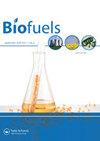The effect of thermal conductivity and stably dispersed graphene nanoplatelets on Sterculia foetida biodiesel–diesel blends for the investigation of performance, emissions, and combustion characteristics on VCR engine
IF 2.6
4区 工程技术
Q3 ENERGY & FUELS
引用次数: 0
Abstract
AbstractThe present study investigates the use of a Sterculia foetida biodiesel–diesel sample (B20) and graphene nanoplatelets (GNPs) at 60 ppm with different agents (non-ionic surfactant Span 80), surfactant cetyl trimethyl ammonium bromide (CTAB), and dispersant (QPAN 80) at various compression ratios (16:1, 17:1, and 18:1) in a diesel engine. The surface-modified GNPs (using an optimum ratio of 1:1 GNPs to agent) were added to the B20 blend using a bath and a probe sonicator. The prepared samples were analyzed for characterization using field emission scanning electron microscopy (FESEM), high-resolution transmission electron microscopy (HRTEM), fourier transform infrared (FTIR), X-Ray diffraction (XRD), thermogravimetric analysis (TGA), and thermal conductivity. The highest stability was observed for the dispersant-added GNPs-B20 blend (B20 + GNPs 60 mg/L + QPAN 80 mg/L). In overall engine performance, brake thermal efficiency (BTE), cylinder pressure (CP), and net heat release rate (NHRR) were increased by 11.56, 18.61, and 15.88%, respectively, whereas brake-specific fuel consumption (BSFC), ignition delay (ID), and combustion duration (CD) were reduced by 27.5, 17.10, and 15.34%, respectively. Carbon monoxide (CO), unburnt hydrocarbon (UHC), nitrogen oxide (NOx), and smoke opacity were reduced by 13.24, 23.04, 5.20, and 59.84%, respectively, for the B20 + GNPs 60 mg/L + QPAN 80 mg/L blend at a higher compression ratio and the maximum load condition. The results ultimately suggest that the blend B20 + GNPs 60 mg/L + QPAN 80 mg/L could be successfully used in diesel engines with no engine modifications.Keywords: Sterculia foetida biodieselsurfactantdispersantgraphene nanoplateletscompression ratiothermal conductivity Future scopeBased on the findings of this study, the combination B20 + GNPs 60 mg/L + QPAN 80 mg/L is recommended at higher CRs. The performance, combustion, and emission characteristics of a diesel engine will be further investigated by adjusting engine input parameters such as injection pressure and injection timing using the same blend.AcknowledgementsThe authors sincerely thank the Department of Mechanical Engineering, GITAM School of Technology, GITAM Deemed to Be University, Visakhapatnam Campus, for providing laboratory facilities to conduct the research work. The authors also thank the Sophisticated Analytical Instrument Facility (SAIF), IIT Bombay, for the analysis of the sample.Disclosure statementNo potential conflict of interest was reported by the authors.Data availability statementThe data is available in the manuscript.热导率和稳定分散的石墨烯纳米片对水蛭生物柴油-柴油混合物的影响,用于研究VCR发动机的性能、排放和燃烧特性
摘要本研究研究了在60 ppm浓度下,用不同压缩比(16:1、17:1和18:1)的剂(非离子表面活性剂Span 80)、表面活性剂十六烷基三甲基溴化铵(CTAB)和分散剂(QPAN 80)在柴油发动机中对一种小茴香生物柴油-柴油样品(B20)和石墨烯纳米片(GNPs)的使用情况。将表面改性的GNPs (GNPs与助剂的最佳比例为1:1)通过浴槽和探针声纳器加入B20共混物中。采用场发射扫描电镜(FESEM)、高分辨率透射电镜(HRTEM)、傅里叶变换红外(FTIR)、x射线衍射(XRD)、热重分析(TGA)和导热系数对制备的样品进行了表征。添加分散剂的GNPs-B20共混物(B20 + GNPs 60 mg/L + QPAN 80 mg/L)稳定性最高。在发动机整体性能方面,制动热效率(BTE)、气缸压力(CP)和净放热率(NHRR)分别提高了11.56%、18.61%和15.88%,而制动油耗(BSFC)、点火延迟(ID)和燃烧持续时间(CD)分别降低了27.5%、17.10%和15.34%。在较高压缩比和最大负荷条件下,B20 + GNPs 60 mg/L + QPAN 80 mg/L混合物的一氧化碳(CO)、未燃烃(UHC)、氮氧化物(NOx)和烟浊度分别降低了13.24%、23.4%、5.20%和59.84%。结果表明,B20 + GNPs 60 mg/L + QPAN 80 mg/L的混合燃料可以在不进行发动机改造的情况下成功用于柴油发动机。关键词:田螺生物柴油表面活性剂分散剂石墨烯纳米血小板压缩比导热系数未来研究范围基于本研究结果,在较高cr时推荐使用B20 + GNPs 60 mg/L + QPAN 80 mg/L的组合。通过调整发动机输入参数(如喷射压力和喷射正时),使用相同的混合燃料,将进一步研究柴油发动机的性能、燃烧和排放特性。作者衷心感谢GITAM理工学院机械工程系,GITAM被认为是大学,维沙卡帕特南校区,为开展研究工作提供实验室设施。作者还感谢印度理工学院孟买分校的精密分析仪器设施(SAIF)对样本的分析。披露声明作者未报告潜在的利益冲突。数据可用性声明数据在手稿中可用。
本文章由计算机程序翻译,如有差异,请以英文原文为准。
求助全文
约1分钟内获得全文
求助全文
来源期刊

Biofuels-Uk
Energy-Renewable Energy, Sustainability and the Environment
CiteScore
5.40
自引率
9.50%
发文量
56
期刊介绍:
Current energy systems need a vast transformation to meet the key demands of the 21st century: reduced environmental impact, economic viability and efficiency. An essential part of this energy revolution is bioenergy.
The movement towards widespread implementation of first generation biofuels is still in its infancy, requiring continued evaluation and improvement to be fully realised. Problems with current bioenergy strategies, for example competition over land use for food crops, do not yet have satisfactory solutions. The second generation of biofuels, based around cellulosic ethanol, are now in development and are opening up new possibilities for future energy generation. Recent advances in genetics have pioneered research into designer fuels and sources such as algae have been revealed as untapped bioenergy resources.
As global energy requirements change and grow, it is crucial that all aspects of the bioenergy production process are streamlined and improved, from the design of more efficient biorefineries to research into biohydrogen as an energy carrier. Current energy infrastructures need to be adapted and changed to fulfil the promises of biomass for power generation.
Biofuels provides a forum for all stakeholders in the bioenergy sector, featuring review articles, original research, commentaries, news, research and development spotlights, interviews with key opinion leaders and much more, with a view to establishing an international community of bioenergy communication.
As biofuel research continues at an unprecedented rate, the development of new feedstocks and improvements in bioenergy production processes provide the key to the transformation of biomass into a global energy resource. With the twin threats of climate change and depleted fossil fuel reserves looming, it is vitally important that research communities are mobilized to fully realize the potential of bioenergy.
 求助内容:
求助内容: 应助结果提醒方式:
应助结果提醒方式:


